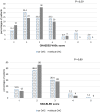Determinants of anticoagulant therapy in atrial fibrillation at discharge from a geriatric ward: cross sectional study
- PMID: 31471772
- PMCID: PMC6954132
- DOI: 10.1007/s11239-019-01937-3
Determinants of anticoagulant therapy in atrial fibrillation at discharge from a geriatric ward: cross sectional study
Abstract
Oral anticoagulants (OACs) are effective in preventing stroke in older people with atrial fibrillation (AF), but they are often underused in this particularly high-risk population. The aim of the study was to identify health and functional determinants of oral anticoagulant therapy (OA) in AF at discharge from a geriatric sub-acute ward. A cross-sectional study was conducted and patients who presented with atrial fibrillation were analyzed. They were interviewed, examined, assessed with comprehensive geriatric assessment protocol, and had their hospital records analyzed. Relative risks for OA were counted and multivariable logistic regression model was built. 95 patients took part in the study (22.8% of 416 consecutively admitted to the department, 31.9% men, 73.7% 80 + year-old). 25.8% of them were on antiplatelet drugs and 58.9% on OACs. The percentage on OACs increased significantly to 73.7% at discharge (p = 0.004), mainly due to the new OACs prescription (from 11.8 to 33.3%; p < 0.001). Severe frailty (7 point Clinical Frailty Scale ≥ 6) and anemia presence, but not the risk of bleeding according to the HAS-BLED score, significantly decreased the probability of OACs prescription at discharge. There was also a trend for an association of OACs prescription with the higher total score of CHA2DS2-VASc scale. We conclude that in the real-life population of patients with AF comprehensive geriatric assessment might allow to increase significantly the number of patients on OACs, but it is limited by patient's frailty status and anemia diagnosis.
Keywords: Atrial fibrillation; Comprehensive geriatric assessment; Frailty; New oral anticoagulant drugs; Older people.
Conflict of interest statement
All authors declare no conflict of interest.
Figures


Comment in
-
Underuse of anticoagulant therapy in hospitalized older patients: comment on the article of Wojszel et al.J Thromb Thrombolysis. 2020 Jan;49(1):136-137. doi: 10.1007/s11239-019-01960-4. J Thromb Thrombolysis. 2020. PMID: 31552544 No abstract available.
-
Underuse of anticoagulant therapy in hospitalized older patients: comment on the article of Wojszel et al.J Thromb Thrombolysis. 2020 Apr;49(3):499-500. doi: 10.1007/s11239-020-02050-6. J Thromb Thrombolysis. 2020. PMID: 32002768 No abstract available.
References
-
- Andersson T, Magnuson A, Bryngelsson IL, Frobert O, Henriksson KM, Edvardsson N, et al. All-cause mortality in 272,186 patients hospitalized with incident atrial fibrillation 1995–2008: a Swedish nationwide long-term case-control study. Eur Heart J. 2013;34(14):1061–1067. doi: 10.1093/eurheartj/ehs469. - DOI - PMC - PubMed
-
- Ruff CT, Giugliano RP, Braunwald E, Hoffman EB, Deenadayalu N, Ezekowitz MD, et al. Comparison of the efficacy and safety of new oral anticoagulants with warfarin in patients with atrial fibrillation: a meta-analysis of randomised trials. Lancet. 2014;383(9921):955–962. doi: 10.1016/S0140-6736(13)62343-0. - DOI - PubMed
-
- Dregan A, Ravindrarajah R, Charlton J, Ashworth M, Molokhia M. Long-term trends in antithrombotic drug prescriptions among adults aged 80 years and over from primary care: a temporal trends analysis using electronic health records. Ann Epidemiol. 2018;28(7):440–446. doi: 10.1016/j.annepidem.2018.03.006. - DOI - PubMed
-
- Tondato F, Shen WK. Cardiac arrhythmias. In: Halter JGO, Studenski S, Hig KP, Sanjay A, Supiano MA, Ritchie C, editors. Hazzard’s geriatric medicine and gerontology. 7. New York: Mc Graw Hill Education; 2017. pp. 1205–1213.
-
- Wojszel Z, Magnuszewski L, Swietek M, Kasiukiewicz A, Zubrewicz K. Frailty and functional correlates of atrial fibrillation in patients admitted to the geriatric ward. Polish Gerontology. 2019;27:11–15.
MeSH terms
Substances
Grants and funding
LinkOut - more resources
Full Text Sources
Medical

